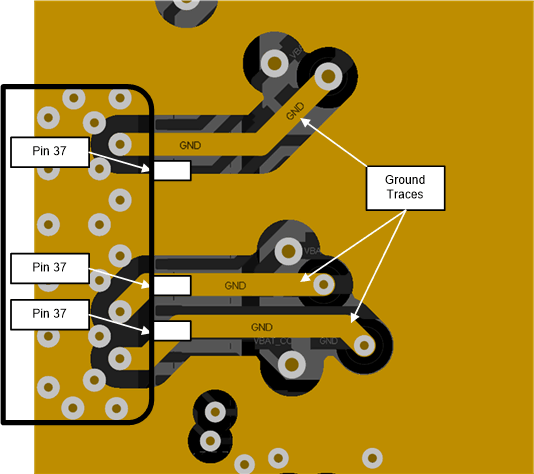ZHCSJU5B February 2019 – May 2021 CC3135
PRODUCTION DATA
- 1 特性
- 2 应用
- 3 说明
- 4 功能方框图
- 5 Revision History
- 6 Device Comparison
- 7 Terminal Configuration and Functions
-
8 Specifications
- 8.1 Absolute Maximum Ratings
- 8.2 ESD Ratings
- 8.3 Power-On Hours (POH)
- 8.4 Recommended Operating Conditions
- 8.5 Current Consumption Summary: 2.4 GHz RF Band
- 8.6 Current Consumption Summary: 5 GHz RF Band
- 8.7 TX Power Control for 2.4 GHz Band
- 8.8 TX Power Control for 5 GHz
- 8.9 Brownout and Blackout Conditions
- 8.10 Electrical Characteristics for DIO Pins
- 8.11 Electrical Characteristics for Pin Internal Pullup and Pulldown
- 8.12 WLAN Receiver Characteristics
- 8.13 WLAN Transmitter Characteristics
- 8.14 WLAN Transmitter Out-of-Band Emissions
- 8.15 BLE/2.4 GHz Radio Coexistence and WLAN Coexistence Requirements
- 8.16 Thermal Resistance Characteristics for RGK Package
- 8.17 Timing and Switching Characteristics
- 8.18 External Interfaces
- 9 Detailed Description
- 10Applications, Implementation, and Layout
- 11Device and Documentation Support
- 12Mechanical, Packaging, and Orderable Information
10.2.2.1 Design Considerations
The following design guidelines must be followed when laying out the CC3135 device:
- Ground returns of the input decoupling capacitors (C12, C14, and C21) should be routed on Layer 2 using thick traces to isolate the RF ground from the noisy supply ground. This step is also required to meet the IEEE spectral mask specifications.
- Maintain the thickness of power traces to be greater than 12 mils. Take special consideration for power amplifier supply lines (pin 33, 40, 41, and 42), and all input supply pins (pin 37, 39, and 44).
- Ensure the shortest grounding loop for the PLL supply decoupling capacitor (pin 24).
- Place all decoupling capacitors as close to the respective pins as possible.
- Power budget—the CC3135 device can consume up to 450 mA for 3.3 V, 670 mA for 2.1 V, for
24 ms during the calibration cycle. - Ensure the power supply is designed to source this current without any issues. The complete calibration (TX and RX) can take up to 17 mJ of energy from the battery over a time of 24 ms.
- The CC3135 device contains many high-current input pins. Ensure the trace feeding these pins can handle the following currents:
- VIN_DCDC_PA input (pin 39) maximum 1 A
- VIN_DCDC_ANA input (pin 37) maximum 600 mA
- VIN_DCDC_DIG input (pin 44) maximum 500 mA
- DCDC_PA_SW_P (pin 40) and DCDC_PA_SW_N (pin 41) switching nodes maximum 1 A
- DCDC_PA_OUT output node (pin 42) maximum 1 A
- DCDC_ANA_SW switching node (pin 38) maximum 600 mA
- DCDC_DIG_SW switching node (pin 43) maximum 500 mA
- VDD_PA_IN supply (pin 33) maximum 500 mA
Figure 10-9 shows the ground routing for the input decoupling capacitors.
 Figure 10-9 Ground Routing for Input Decoupling Capacitors
Figure 10-9 Ground Routing for Input Decoupling CapacitorsNote:
The ground returns for the input capacitors are routed on layer two to reduce the EMI and improve the spectral mask. This routing must be strictly followed because it is critical for the overall performance of the device.
 Figure 10-10 Ground Returns for Input Capacitors
Figure 10-10 Ground Returns for Input Capacitors